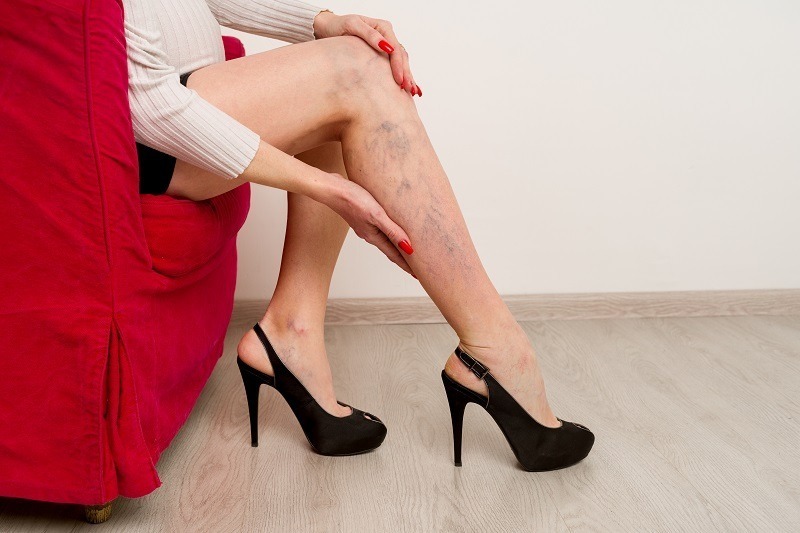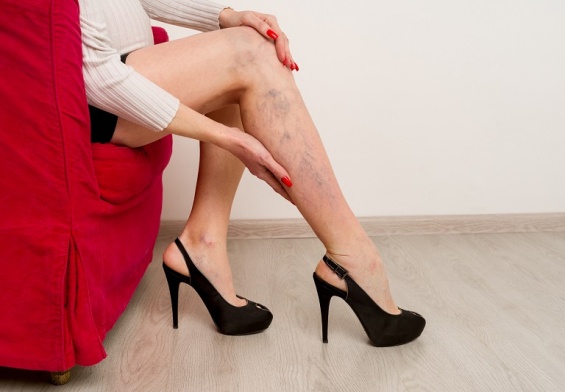Varicose Veins or Spider Veins are common in men and women (20% of men and 40% of women get Venous disease). Why do women suffer more than men with vein problems? For women pregnancy and hormonal fluctuations (namely progesterone) are the biggest culprits. Swelling of the legs, a/k/a edema is more prevalent in men, with superficial thrombophlebitis more likely to affect women.
If you’re lucky enough to have remained unscathed by any type of venous disease thus far in your life, just wait a little longer. People in their 70s are twice as likely to have venous disease as those in their 40s. A lifetime of activities like heavy lifting, coughing, and even straining to have a bowel movement, all contribute to pressure on leg veins. A sedentary lifestyle, obesity and a diet high in fat are all contributing factors to venous issues, because a fatty diet and lack of exercise decrease the efficiency of blood flow through large leg veins, thus increasing the likelihood of developing varicose veins or spider veins.
About Spider Veins

Spider veins and other types of venous disease wreak havoc with your health. Certainly, no one wants to undergo a battery of tests or treatments in a doctor’s office, or undergo elective surgery, unless your quality of life becomes so poor and pain-riddled, that there are no other options.
There are several interesting approaches to treating spider veins. Topical treatments, like those below, work well on varicose veins, but, spider veins may be stopped in their tracks through the technique of “dry skin brushing”.
Methods to help varicose veins
- Use Horse Chestnut, an herbal extract, available in a topical cream form, which, when applied to the skin, has been shown in studies to strengthen veins and reduce swelling.
- Apply Castor oil, directly after bathing, over all of the varicose veins, gently massaging the oil into the affected areas, right down to your feet for the most benefit.
Dry skin brushing
Dry skin brushing is simple to do and has many benefits, among them preventing or reducing unsightly and dangerous varicose veins and spider veins. Dry skin brushing is cheap and healthy – translation: no harmful side effects, means of remedying several health concerns.
How to Dry brush your skin
Not only do you need the proper technique as outlined below, but you also need the proper brush which is available at most health food stores. Buy a long-handled brush so you can reach hard-to-access areas like your back. Firm bristles are best, typically cactus- or vegetable-derived, or else the process won’t work. As an example, see: Bernard Jensen’s Body Brush, and Natural Bristle Brush.
Dry brushing energizes and stimulates the body, most pros who tout the technique suggest you do it in the morning right before you shower (but any other time also works just fine). While you can go from head to toe or in reverse, dry skin brushing benefits your lymphatic system so it is best to work from the feet and go in an upward direction to help lymph fluids go toward the heart. Stroking away from your heart puts extra pressure on the valves within the veins and lymph vessels and can cause ruptured vessels and varicose veins.
Start by grasping the brush and use it to make long, sweeping strokes from the bottom of your feet upwards, then from the hands towards the shoulders, and on the torso keeping the upward direction.
Be sure to avoid any sensitive areas and/or anywhere the skin is broken such as areas of skin rash, wounds, cuts, and infections. Again, take special care to avoid any raised veins (like varicose) as the pressure may worsen them. Simply skip over this area.
Finish up the skin brushing with your regular shower and end with three hot-and-cold cycles. The hot-and-cold cycle means turning on the water as hot as you can stand it for several seconds, then as cold as you can tolerate it, repeat this routine three times. The hot-and-cold cycles help to invigorate the skin and stimulate blood circulation, bringing more blood to the outer layers of the skin.
Benefits of dry skin brushing
- Improved circulation – Dry skin brushing will help to promote circulation and assist in the return of blood toward the heart. The strokes will help prevent the pooling of blood in certain areas of the body, most notably, the legs. The biggest benefit to improved circulation in the legs is that dry skin brushing is a proactive means to prevent varicose veins and spider veins from becoming problematic during the natural and normal aging process. You should note that it is safe to gently dry brush over existing spider veins, but you should be extra gentle and very careful with varicose veins, as you don’t want to irritate them or do anything to make them worse.
- Improve your lymphatic system.
- Improved immune health – Dry skin brushing helps to improve your lymphatic system. The purpose of your lymphatic system is to transport white blood cell-rich fluid called lymph throughout the body to remove harmful toxins. When your lymphatic system is not functioning properly, the result is an accumulation of toxins and delayed detection of infectious materials, resulting in illness. When your lymphatic system works 100%, your immune system can fight off viruses, bacteria, or other infectious substances. Since dry skin brushing helps move lymph through the body efficiently, the incidence of inflammation is reduced throughout the body. Anyone would benefit from this treatment.
- Improved organ function: Although there’s no conclusive evidence to support this claim, many doctors believe the practice of regular dry brushing helps improve the function of many other organs, including the liver and kidneys. That’s because it massages the lymph nodes and encourages the removal of excess water and toxins in the body. By speeding up the natural detoxification, you’re helping to improve the function of your other organs.
- The top reason people opt for dry skin brushing, is to reduce cellulite, that bumpy cottage cheese syndrome that settles onto thighs and rear ends. Dry brushing makes hard fat cells under the skin softer, helping to more evenly distribute them. Dry brushing helps rid the body of specific toxins that cause connective tissues below the skin to break down, resulting in stronger connective tissues and less cellulite bulges.
FAQs About Varicose and Spider Veins:
- Q: Does Dry Brushing Work for Varicose and Spider Veins? A: While dry brushing can offer temporary relief from the discomfort of varicose and spider veins, it’s not a cure. It can help stimulate blood flow and improve circulation, which may reduce swelling and pain. However, for long-term management or elimination of these conditions, it’s often necessary to consult a healthcare professional for more targeted treatments, such as sclerotherapy, laser therapy, or surgical procedures.
- Q: What are some other effective treatments for spider veins besides dry brushing? A:
-
-
Sclerotherapy:
- How it works: A solution is injected into the vein, causing it to collapse and fade.
- Effectiveness: Often effective for small to medium-sized spider veins.
- Recovery: Minimal downtime, but some bruising or swelling may occur.
Laser Therapy:
- How it works: Concentrated light is used to destroy the blood vessels in the vein.
- Effectiveness: Can be effective for both spider and varicose veins.
- Recovery: Minimal downtime, but some redness or swelling may occur.
Endovenous Laser Ablation (EVLA):
- How it works: A laser is used to heat and seal the affected vein.
- Effectiveness: Highly effective for varicose veins.
- Recovery: Minimal downtime, but some discomfort or bruising may occur.
Radiofrequency Ablation:
- How it works: Similar to EVLA, this procedure uses radiofrequency energy to close the vein.
- Effectiveness: Highly effective for varicose veins.
- Recovery: Minimal downtime, but some discomfort or bruising may occur.
Thermal Ablation:
- How it works: This is a general term for procedures that use heat to close the vein, such as EVLA and radiofrequency ablation.
- Effectiveness: Highly effective for varicose veins.
- Recovery: Minimal downtime, but some discomfort or bruising may occur.
ClariVein:
- How it works: A medical adhesive is applied to the vein, followed by a laser that heats and closes the vein.
- Effectiveness: Highly effective for varicose veins.
- Recovery: Minimal downtime, but some discomfort or bruising may occur.
VenaSeal:
- How it works: A bioadhesive is injected into the vein, causing it to collapse and seal.
- Effectiveness: Highly effective for varicose veins.
- Recovery: Minimal downtime, but some discomfort or bruising may occur.
Phlebectomy:
- How it works: The affected vein is surgically removed.
- Effectiveness: Effective for larger varicose veins.
- Recovery: More significant downtime and potential scarring.
-
-
Which of these treatments might be suitable for you depends on the severity of your varicose or spider veins and your individual medical history. It’s always best to consult with a healthcare professional to discuss your options and determine the most appropriate treatment plan.
- Q: What lifestyle changes can help prevent new varicose and spider veins from forming? A: Regular exercise, maintaining a healthy weight, avoiding prolonged standing or sitting, wearing compression stockings, limiting salt intake, and quitting smoking can all help prevent the development of varicose and spider veins.
- Q: What causes varicose and spider veins? A: Weak vein walls, increased pressure on the veins, genetics, and hormonal changes can contribute to the development of varicose and spider veins.
- Q: What are the effective treatments for varicose and spider veins? A: Sclerotherapy, laser therapy, EVLA, radiofrequency ablation, phlebectomy, and compression stockings are common treatments for varicose and spider veins.
- Q: What is the connection between circulation and varicose veins? A: Poor circulation can contribute to the development of varicose veins. When blood doesn’t flow properly, it can pool in the veins, causing them to become enlarged and twisted.
- Q: How does dry brushing affect the appearance of the skin? A: Dry brushing can exfoliate the skin, removing dead cells and promoting cell turnover. This can help improve skin texture and appearance. However, it does not directly affect the appearance of varicose or spider veins.



